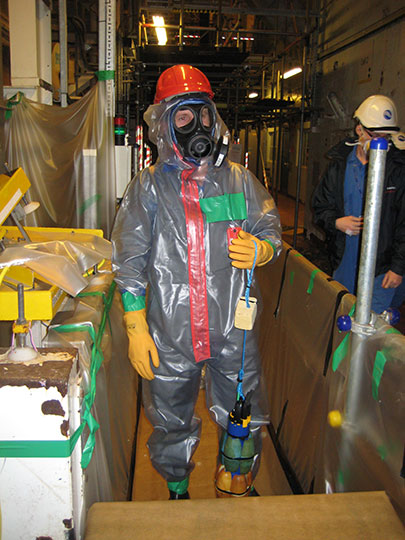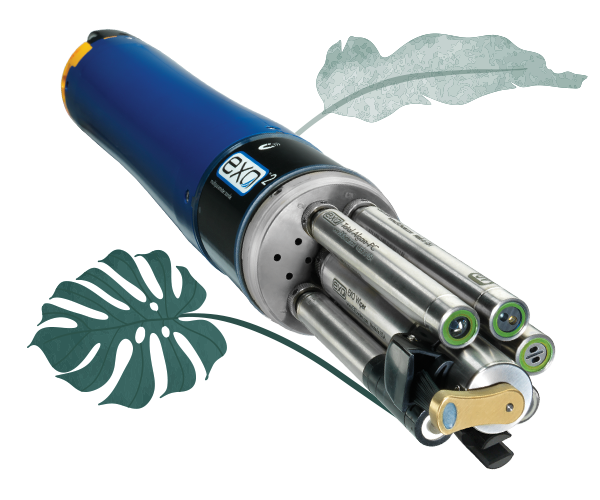
Monitoring Sellafield's Nuclear Waste and Legacy Ponds with EXO Sondes
Nuclear Waste Pond Monitoring with EXO Instruments
After undergoing a thorough evaluation process, EXO water quality monitoring sondes are now being utilised in one of the most challenging environments possible - the nuclear waste legacy storage ponds at the Sellafield nuclear reprocessing site in Cumbria, UK.
Background

Sellafield Ltd faces a significant challenge in safely decommissioning the First Generation Magnox Storage Pond (FGMSP), a nuclear fuel storage facility constructed in the 1950s and 1960s to accommodate irradiated Magnox fuel for cooling before reprocessing. In the 1970s, elevated levels of fuel corrosion and radiation were observed due to an extended shutdown at the Magnox Reprocessing Plant, coupled with higher fuel throughput caused by electricity shortages, leading to prolonged storage of spent fuel in the pond beyond its initial timeframe.
Over time, the pond has amassed substantial amounts of waste materials, including sludge resulting from fuel cladding corrosion, containers of fuel, fuel remnants, and various debris that have been deposited into the pond, making water monitoring highly difficult due to its diminished water quality.
This open pond, standing at a depth of 5 meters (16 feet) above ground and containing around 14,000 cubic meters of contaminated water (equivalent to approximately two Olympic swimming pools), is identified as a top priority for decommissioning.
To facilitate future retrievals, a comprehensive understanding of the facility's inventory necessitates a visual examination of the pond. Despite the presence of elevated radioactivity levels, this open pond occasionally experiences blooms of various microorganisms that obscure the water, diminishing visibility and impeding water quality inspection and retrieval efforts.
Sellafield Ltd, tasked with the safe execution of decommissioning, reprocessing, and nuclear waste management operations on behalf of the Nuclear Decommissioning Authority (NDA), has a project team under the leadership of Xavier Poteau dedicated to implementing monitoring technologies for the FGMSP pond.
They have implemented a water quality testing system where the water that flows through the pond eventually reaches the Sellafield Ion Exchange Effluent Plant (SIXEP), where radioactivity is extracted from liquid streams in various facilities throughout the Sellafield site. The plant utilises a carbonation method to settle and filter out solids, neutralising the alkaline pond water, and then employs ion exchange to eliminate radionuclides, therefore enhancing and rejuvenating water quality.
Why Monitor?
Regularly, water samples are gathered from the pond for laboratory testing, with the water analysis results being shared with the Environment Agency (EA) and the NDA. Apart from meeting regulatory obligations, water quality information is essential for the effective functioning of SIXEP and to guarantee that legacy fuel is stored under ideal conditions. As an illustration, caustic dosing is carried out to uphold a pH level of approximately 11.5, which helps in slowing down the degradation of nuclear fuel.
Water Monitoring Challenges
Due to physical constraints, water samples can only be collected from designated areas along the perimeter of the pond. Given the radioactive nature of the water, routine samples are restricted to approximately 100 mL to adhere to laboratory protocols. Sampling is a laborious and time-intensive task, requiring the presence of two individuals. Each sampler must don a PVC suit, facemask, two sets of PVC waterproof gloves, and a pair of Kevlar gloves to prevent accidental punctures. Additionally, samplers are permitted to remain near the pond for a limited duration.

While instrumentation may seem like a straightforward remedy, numerous challenges exist, including the requirement for gamma spectrum analysis to be performed on a sample in a laboratory. Moreover, electrical instruments frequently malfunction in radioactive settings, leading to the general presumption that they will fail unless demonstrated otherwise.
The utilisation of continuous monitoring probes, akin to those utilised in the water industry, is not viable due to the extensive wiring needed, as seen in the monitoring of the Zambezi River with YSI EXO2. Nonetheless, portable instruments present an opportunity to decrease the amount and regularity of water sampling.

Trials with EXO Sondes
The EXO2 sondes are advanced multiparameter 6-port water quality monitors specifically designed for remote, extended monitoring purposes. Widely utilised by regulatory bodies, scientists, industrial entities, and individuals tasked with safeguarding water sources worldwide, these sondes are the culmination of extensive development efforts and input from numerous users across the globe over several years. Their effectiveness extends beyond extreme environments, offering reliable solutions in more everyday applications such as bottled water quality monitoring.
Consequently, these devices are designed to be durable and lightweight, equipped with internal batteries and data logging functionality suitable for extended monitoring tasks. The EXO sondes are engineered to operate on minimal power consumption and include various functionalities to reduce maintenance needs and prevent biofouling. For instance, corrosion-resistant wet-mateable connectors are utilised, components are isolated to prevent short-circuits, welded housings and double o-rings are employed to prevent leaks, and high-impact plastic and titanium materials are used to withstand impact damage.
“...EXO sondes have performed very well ‘off the shelf’ [in a radioactive environment] which is a sign of good design.”

The versatile EXO sensors can be effortlessly swapped out, allowing users to choose the sensors that align with their specific requirements.
The FGMSP project team utilises sensors for pH, temperature, conductivity, turbidity, fDOM (Fluorescent Dissolved Organic Matter – a proxy for Coloured DOM), Blue-green Algae, and Chlorophyll.
At the outset, the FGMSP project team tested an extended deployment iteration of the YSI 6600 multiparameter water quality monitoring sonde – a precursor to the EXO. Technical Specialist Marcus Coupe remarked, "This enabled us to assess the quality of the YSI sensors and demonstrate that they were able to operate well in a radioactive environment." He further noted, "The launch of the EXO was of great interest to us because, with Bluetooth communications and smart sensors that retain their calibration data, the EXO offered an opportunity to dramatically reduce time spent at the pond."
“The launch of the EXO was of great interest to us because...[it] offered an opportunity to dramatically reduce time spent at the pond.”
“The snap-on probes are calibrated in the laboratory and can then be quickly and simply swapped with those that have been deployed on an EXO sonde. This means that the main part of the sonde can be left onsite while the sensors are quickly swapped, and the Bluetooth comms enable us to collect 18,600 sets of data in less than 20 minutes.”
Expanding on the positive outcomes of the EXO trials, Xavier Poteau remarked, "It has been a common experience in the nuclear industry to have to apply significant adaptations to electrical equipment so that it can function correctly in a radioactive environment, and this can incur a heavy cost and time penalty. However, the EXO sondes have performed very well ‘off the shelf’ which is a sign of good design.”
In their utilisation of the EXO sondes, the FGMSP project team has employed an EXO sonde in conjunction with a submersible remotely operated vehicle (ROV). This allowed the team to monitor water quality in areas previously inaccessible and enhance waste management processes. Marcus Coupe commented, "Any reduction in visibility in the pond could pose a significant operational risk in the legacy ponds and potentially impede future retrievals. Therefore, the capability to deploy an EXO with an ROV provides valuable insights into comprehending the challenge, transitioning from single-point sampling to a more comprehensive 3D data stream."
Looking Forward
Neill Cornwell, representing Xylem Analytics, has been engaged in the trials at Sellafield since their inception. He stated, "A lot of hard work has gone into the process of demonstrating EXO’s suitability for deployment in the nuclear sector; not only has the equipment had to perform well in challenging conditions, but we have also had to demonstrate a high level of technical and service support.”

“Naturally, we are very pleased that the sondes have performed so well, and further instruments are now being deployed in other applications at the Sellafield site. For example, a slimmer version of the EXO, the EXO1, is being used to monitor the effluent distribution tanks because the only access is via narrow pipes and the EXO1 is ideal because its outer diameter is just 1.85 inches.”
Xavier Poteau is confident that the data obtained from the FGMSP sondes align well with the outcomes of laboratory analysis “a high level of confidence is being established in the EXO data and this means that we will be able to reduce the amount of sampling that we undertake, which will save a great deal of time, hassle and money.”
“I strongly believe that our experience could be beneficial to the wider audience as well as the nuclear industry.”
|
To find out more: |
